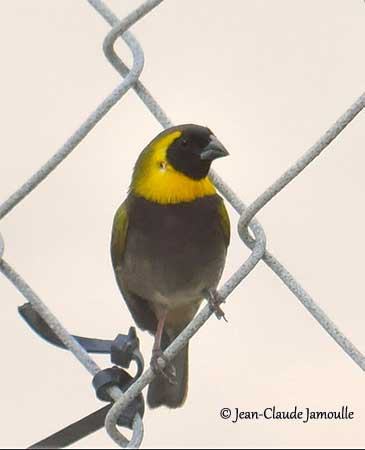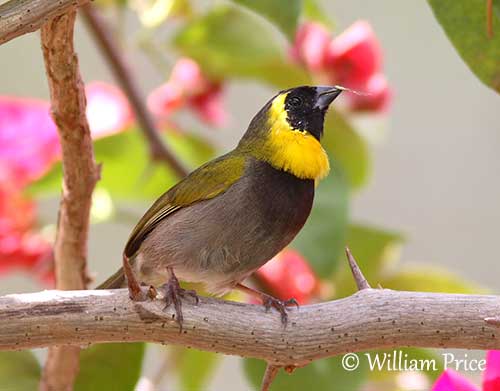
Fr: Sporophile petit-chanteur - Cici petit-chanteur
Ang: Cuban Grassquit - Melodious Grassquit
All: Kubagimpelfink
Esp: Semillero Canoro
Ita: Erbero di Cuba
Nd: Kleine Cubavink
Sd: kubagräsfink
Photographers:
Jean-Claude Jamoulle
A la rencontre des Oiseaux
William Price
PBase-tereksandpiper & Flickr William Price
Text by Nicole Bouglouan
Sources:
HANDBOOK OF THE BIRDS OF THE WORLD Vol 16 by Josep del Hoyo- Andrew Elliot-David Christie – Lynx Edicions – ISBN: 9788496553781
BIRDS OF THE WEST INDIES – by Herbert Raffaele, Kristin Williams et Tracy Pedersen – Helm – ISBN: 9780713649055
Neotropical Birds – Cornell Lab of Ornithology
Cuba Explorer - Birds of Cuba - Endemic and near endemic birds of Cuba
Finch Information Center - The Cuban Melodious Finch
Territorial, courtship and duet songs of the Cuban Grassquit (Tiaris canora) by Luis F. Baptista
Cuban Grassquit
Tiaris canorus
Passeriformes Order – Thraupidae Family
INTRODUCTION:
The grassquits of genus Tiaris and some other seedeaters, seed-finches and grass-finches, form a widespread and diverse group of small seed-eating Neotropical species. They are now placed with the tanagers in the family Thraupidae.
The Cuban Grassquit is endemic to Cuba and is a very attractive bird. It frequents a variety of habitats from coasts to cultivated areas and open pine forests.
The species has been introduced to the island of New Providence in the Bahamas in the early 1960s, and this nice bird is common in this area.

DESCRIPTION OF THE BIRD:
Biometrics:
Length: 11-12 cm
Weight: 6-10 g
The Cuban Grassquit adult male has greenish to olive back, wings and tail. The primaries have yellowish edges.
On the underparts, the lower breast is black, while belly and breast sides are greyish. The undertail-coverts are paler grey.
On the head, face and throat are black, forming a conspicuous mask. The crown is grey to olive-grey. A bright yellow patch extends from above the eye and around the ear-coverts to the lower throat, forming a broad collar often broken in the centre. The strong contrast between the black mask and the bright yellow collar makes this bird very attractive.
The conical bill is black. The eyes are dark brown. Legs and feet are pale pinkish to flesh.
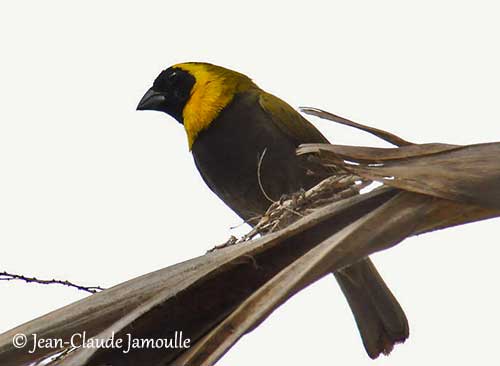
The female resembles male but she is duller. She has dark chestnut face rather than black. The yellow collar is much paler and she has grey underparts, including the lower breast.
The juvenile resembles female but it is much duller.
RANGE:
The Cuban Grassquit is endemic to Cuba where it is fairly common. The species has been introduced to the Bahamas on New Providence Island in 1963, and it is relatively common throughout the island.
HABITAT:
The Cuban Grassquit frequents subtropical and tropical moist forests, both in lowlands and mountains, coastal shrubs and cultivated areas. It is usually found in semi-arid country, wood edges and bushy areas, plantations (coffee and citrus), from sea-level to mid-elevations.
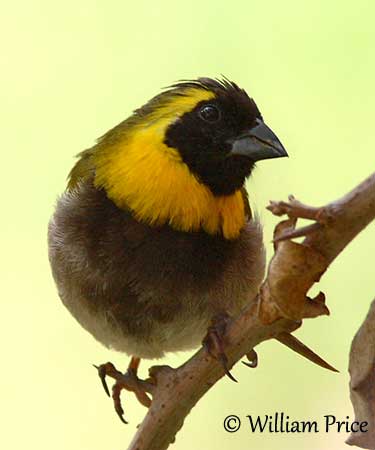
CALLS AND SONGS: SOUNDS BY XENO-CANTO
The Cuban Grassquit produces a shrill, raspy sound, very similar to the song of the Bee Hummingbird “chiri-wichi-wichi, chibiri-wichi-wichi”. We can also hear a common “chip”.
This species has a pleasant whistle, giving the bird its second name “Melodious Grassquit”.
BEHAVIOUR IN THE WILD:
The Cuban Grassquit feeds mainly on seeds, small fruits and tender shoots. It feeds often on the ground, taking small seeds from stems by leaping upwards.
It is commonly seen in flocks outside the breeding season, sometimes with the Yellow-faced Grassquit (Tiaris olivaceus). During the breeding period, they can be seen in pairs with both mates foraging together.
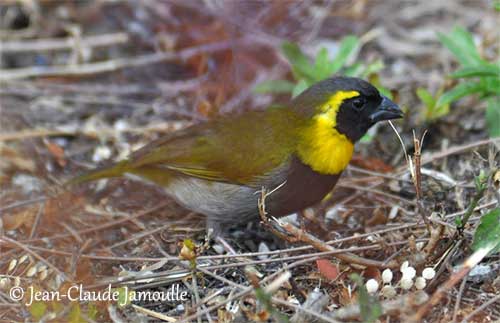
At the beginning of the breeding season, the new pairs perform full courtship rituals, whereas the established pairs skip some of all courtship displays, with only a brief song and some courtship feeding prior to copulation.
The full courtship displays involve duet by both mates and courtship feeding by male to female. Then, she crouches low and lifts both head and tail, ready for copulation. The contrasting black and yellow head pattern of the male is enhanced during the displays by head movements.
The male defends the territory and can become very aggressive. However, several males of the same area often form strong bonds and cooperate to attack other species that invade their territories. But the females are very active and can be aggressive too.
The Cuban Grassquit is sedentary and remains on Cuba all year round. It only performs short flights from its nest-site to its feeding areas.
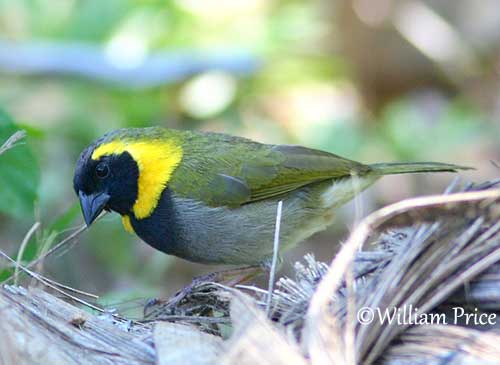
REPRODUCTION OF THIS SPECIES:
The breeding season may extend from March to October, with peak in April/June.
The nest is typically placed low in the vegetation, and it is built by both mates. This is a bulky, spherical, roofed structure with side-entrance. The inner part of the nest is lined with softer materials.
The nest is made with woven dried grasses and it is often placed among spiny vegetation for better protection.
The female lays 2-3 white eggs with brown markings on the wider end. She incubates alone during 11-13 days. The chicks are fed by both parents and grow fast. The female often re-nests while the male rears the chicks of the first brood and feed them for up to a month. The young fledge between 12 and 17 days after hatching.
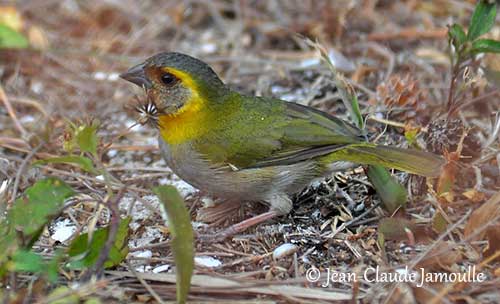
Female
New Providence , Bahamas
PROTECTION / THREATS / STATUS:
The Cuban Grassquit is fairly common throughout its restricted range, both in Cuba and the Bahamas. However, some declines are reported near human settlements, and trapping for cagebird trade probably affects the population. But this species is also threatened by deforestation.
The Cuban Grassquit is currently evaluated as Least Concern.
